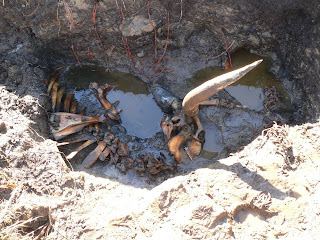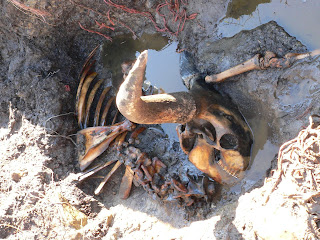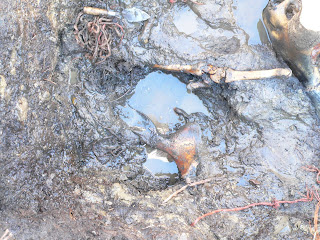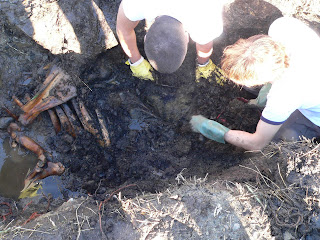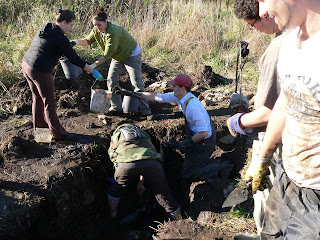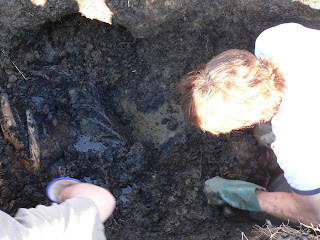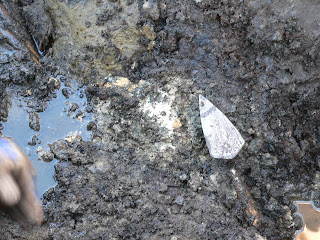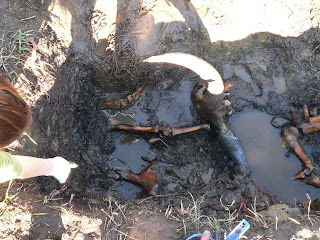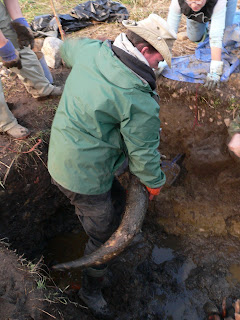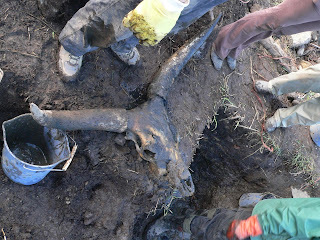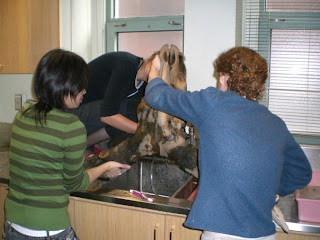As much as we'd like to keep digging up various exotic animals well into December, it was probably a good time to put a pause on any further excavation. The days are getting significantly shorter each week, and when we arrived at the site last Friday there was a substantial amount of ice floating on top of the water that normally fills all of our pits. As well, we managed to get the majority of the Watusi out, and so are in a good position to begin re-articulating and putting the skeleton together for Parc Safari over the winter. We're missing a few carpals, tarsals, and phalanges, but we hopefully should be able to have something to show for ourselves in a few months time, display-wise.
When we got to the site, we set out to prepare the area as much as possible for the winter. More specifically, this involved filling in all the holes we weren't going to be using, and marking off the pits that will remain open. While the excavation area is relatively secluded, somebody out walking or riding their snowmobile may fall into an open pit if enough snow has piled up to conceal its contours. Naturally, we really, really don't want something like that to happen, and so we shoveled dirt back into every pit we dug except M-5 (the watusi pit) and M-10 (the elephant pit), as we hope to be able to excavate the elephant (and/or the mystery bovid lying just outside the current walls of the watusi pit) next season. We then made a series of stakes, placed them along the edges of our two pits, and strung rope around them. Hopefully, this will be enough to stop anyone from getting too close.
The other thing we needed to do before we could leave was to finish our total station mapping of the area, and this included exploring what was going on on the other side of the road. Because we had so much work to do on the north side this fall, we hadn't really looked around across the street, and so what we found last Friday may be worth investigating and test-pitting next year. Essentially, what we had assumed was a relatively small, natural elevation turns out to a large pile of highly disturbed soil. There were even a large femoral epiphysis (the end of a femur) lying on the surface underneath some light vegetation at the top of the mound. This dirt could be the soil that was removed when Magic was buried, or may have come from another burial event. If so, it may be full of the bones of burials that preceded Magic or the watusi, which is pretty neat.
In terms of excavation on our final day, we fished the bag of bird bones in the watusi pit (there actually turned out to be two bags, but we left one in the pit) out and sifted through its contents. Inside are what appears to be the remains of at least two birds, complete with leg bands on the tibiae and everything. Most, but not all, of the flesh had decomposed to a brown liquid, as well as the feathers (although their cores remained). Interestingly, some pieces of cartilege did survive, floating about in the decomposed goo that was once bird meat. We did what we could to separate the bones and feather cores from the other contents of the bag using a sieve, and took the rest back to the lab with us. As well, we found a mysterious canvas sack full of small mammal bones that no one seems to remember excavating. It seems that, when all of our backs were turned to the watusi pit, this bag magically appeared. Not wanting to look a gift horse in the mouth, we took it with us as well.
Real quick, here are some pictures from our last day:
 Above: The white you see is, for the first time at our site, not fat. It's ice.
Above: The white you see is, for the first time at our site, not fat. It's ice. Above: The shadows are getting longer, and the temperature is dropping. We probably snagged the last nice day to get work any done until next year.
Above: The shadows are getting longer, and the temperature is dropping. We probably snagged the last nice day to get work any done until next year. Above: Emptying the contents of the bird bag onto a sieve. One thing that we've all learned from doing this dig is that there is always something out there that will disgust you, no matter how prepared you think you are.
Above: Emptying the contents of the bird bag onto a sieve. One thing that we've all learned from doing this dig is that there is always something out there that will disgust you, no matter how prepared you think you are. Above: Another look at the contents of the bird bag. Note the leg-band.
Above: Another look at the contents of the bird bag. Note the leg-band. Above: The Watusi pit, in full safety mode. Hopefully the snow won't pile up over the height of the rope.
Above: The Watusi pit, in full safety mode. Hopefully the snow won't pile up over the height of the rope. Above: The femur end we found on the mound on the south side of the road. This thing is huge, and doesn't seem to have come from a bovid. If it turns out to be something interesting, we'll be sure to post it.
Above: The femur end we found on the mound on the south side of the road. This thing is huge, and doesn't seem to have come from a bovid. If it turns out to be something interesting, we'll be sure to post it.As far as more posts for the blog are concerned, there are likely to be more pictures coming, as well as some brief updates on the status of our lab work and our upcoming skeleton assembly. It would be nice if we could put up some images of the bird skeleton, which is really cool, or the ever-growing pile of cleaned watusi bones we have sitting in the lab. We may be done digging, but we aren't done with this project by a long shot.
Anyways, that's all for now,
The Field School
